WASHINGTON, D.C. -- The U.S. Payroll to Population employment rate (P2P), as measured by Gallup, continued to climb in June. The percentage of Americans employed full time for an employer last month, 45.0%, is up from 44.5% in May and ranks as one of the highest rates since tracking began in January 2010. The high of 45.7% was measured in October 2012.
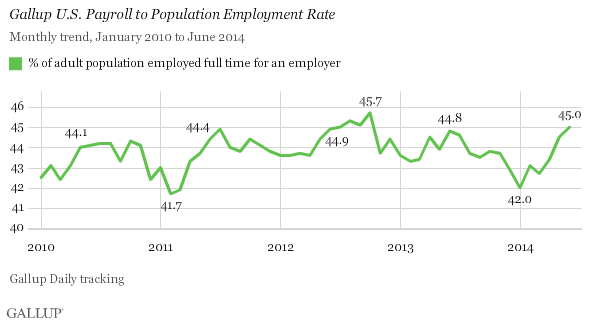
Gallup's P2P metric tracks the percentage of the U.S. adult population aged 18 and older that are employed by an employer for at least 30 hours per week. P2P is not seasonally adjusted. However, because of seasonal fluctuations, year-over-year comparisons are often helpful in evaluating whether monthly changes are attributable to seasonal hiring patterns or true growth (or deterioration) in the percentage of people working full time for an employer. The P2P rate in June tends to be on the high side, including a 44.8% reading in June 2013 and 44.9% in June 2012.
The latest results are based on Gallup Daily tracking interviews with approximately 29,000 Americans, conducted June 1-30 by landline telephone and cellphone. Gallup does not count adults who are self-employed, work less than 30 hours per week, are unemployed, or are out of the workforce as payroll-employed in the P2P metric.
The increase in the P2P rate suggests that more adult Americans have full-time work than has been the case in recent months, which overall suggests an increasingly robust economy.
Seasonal Unemployment Declines to 6.5%
Unlike Gallup's P2P rate, which is a percentage of the total population, traditional employment metrics -- such as the unemployment rates that Gallup and the U.S. Bureau of Labor Statistics (BLS) report -- are percentages of the workforce. Gallup defines the "workforce" as adults who are working or are actively looking for work and available for employment. The U.S. workforce participation rate in June was 67.4%, similar to the 67.6% recorded in May but down from 68.5% in June 2013.
Gallup's unadjusted U.S. unemployment rate for June was 6.8%, down from 7.0% in May -- marking the lowest monthly rate Gallup has measured since it first began tracking employment in January 2010. This continues an almost unbroken decline in unemployment since early 2011, when the rate peaked above 10%.
Gallup's seasonally adjusted U.S. unemployment rate for June dropped even further, from 7.2% to 6.5%. This is also the lowest Gallup has recorded for this survey. This rate is calculated by applying the adjustment factor the government used for the same month in the previous year. Last year, the government adjusted June's rate downward by 0.3 points. The exact adjustment the government will use for June 2014 will not be known until Thursday's BLS release.
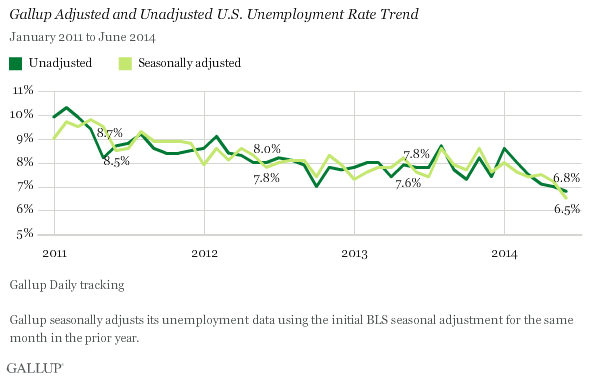
Gallup and BLS unemployment data are both based on large national samples, and Gallup's employment numbers generally correlate with BLS rates. However, the two surveys have important methodological differences, and the numbers will differ slightly from month to month.
Underemployment, as measured by Gallup without seasonal adjustment, was 15.8% in June. This is down from 16.4% in May and from 17.2% in June 2013, and is the lowest that Gallup has recorded. Gallup's U.S. underemployment rate includes adults in the workforce who are unemployed (6.8%) and those who are working part time but looking for full-time work (9.0%).
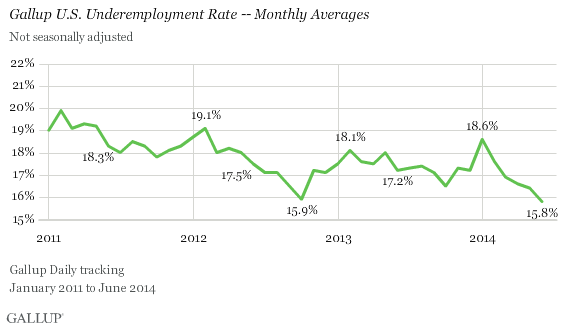
Bottom Line
The trends in Gallup's employment measures are unmistakably positive, with the P2P employment rate nearing its four-year high and the unemployment rate the lowest it has been since Gallup began tracking it. Those trends also align with record-high scores on Gallup's Job Creation Index, based on employees' reports of hiring activity where they work.
Gallup's P2P monthly average for June typically is one of the highest each year, so a decline in July would not be unexpected, but an increase would spell even more good news for job seekers and the economy.
A strong job market is obviously a major pillar of a healthy economy, along with economic growth and strong consumer spending. And while few might agree that the economy has fully recovered from the Great Recession, there is no doubt that the job market is much stronger now than in prior years.
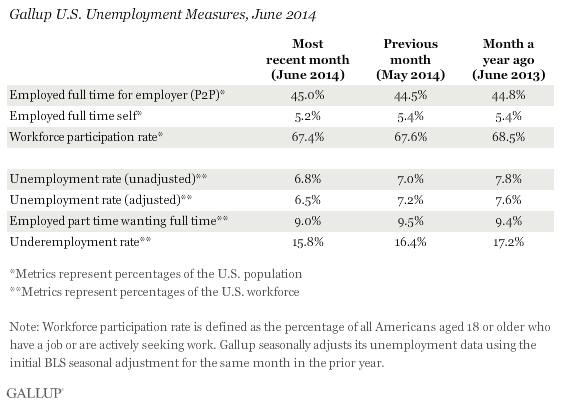
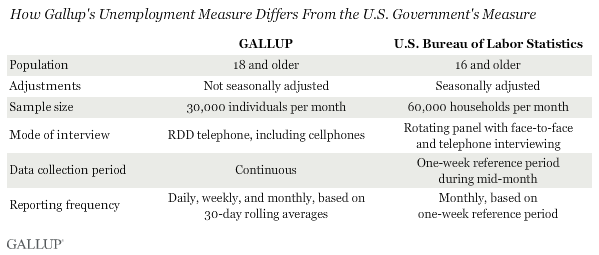
Gallup.com reports results from these indexes in daily, weekly, and monthly averages and in Gallup.com stories. Complete trend data are always available to view and export in the following charts:
Daily: Employment, Economic Confidence, Job Creation, Consumer Spending
Weekly: Employment, Economic Confidence, Job Creation, Consumer Spending
Read more about Gallup's economic measures.
View our economic release schedule.
Survey Methods
Results for this Gallup poll are based on telephone interviews conducted June 1-30, 2014, on the Gallup Daily tracking survey, with a random sample of 29,390 adults, aged 18 and older, living in all 50 U.S. states and the District of Columbia.
For results based on the total sample of national adults, the margin of sampling error is ±1 percentage point at the 95% confidence level.
Interviews are conducted with respondents on landline telephones and cellular phones, with interviews conducted in Spanish for respondents who are primarily Spanish-speaking. Each sample of national adults includes a minimum quota of 50% cellphone respondents and 50% landline respondents, with additional minimum quotas by time zone within region. Landline and cellular telephone numbers are selected using random-digit-dial methods. Landline respondents are chosen at random within each household on the basis of which member had the most recent birthday.
Samples are weighted to correct for unequal selection probability, nonresponse, and double coverage of landline and cell users in the two sampling frames. They are also weighted to match the national demographics of gender, age, race, Hispanic ethnicity, education, region, population density, and phone status (cellphone only/landline only/both, and cellphone mostly). Demographic weighting targets are based on the most recent Current Population Survey figures for the aged 18 and older U.S. population. Phone status targets are based on the most recent National Health Interview Survey. Population density targets are based on the most recent U.S. census. All reported margins of sampling error include the computed design effects for weighting.
In addition to sampling error, question wording and practical difficulties in conducting surveys can introduce error or bias into the findings of public opinion polls.
For more details on Gallup's polling methodology, visit www.gallup.com.
